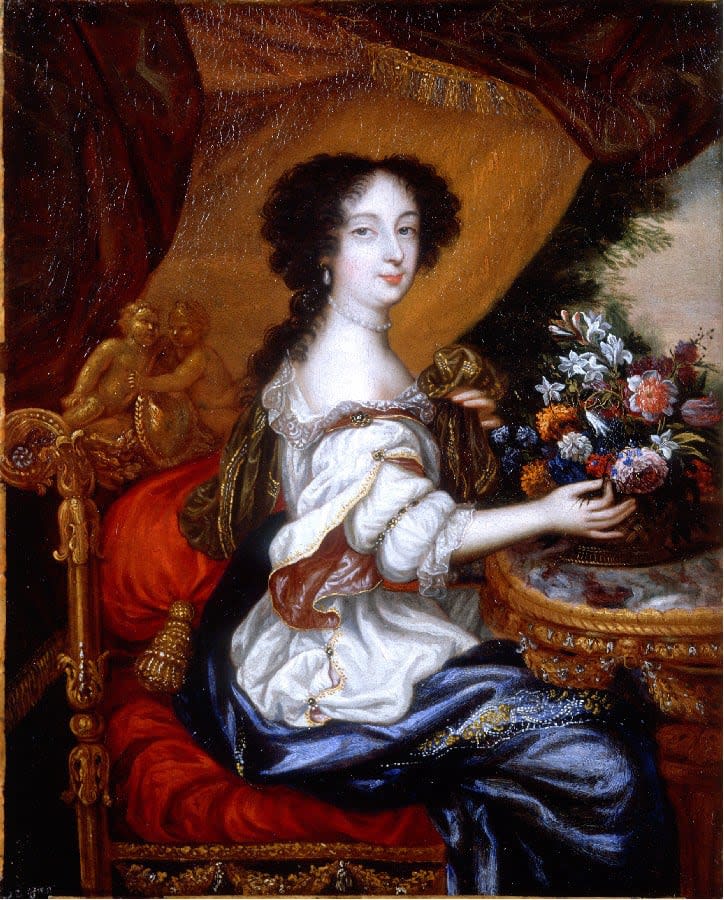
Henri Gascars
Portrait of Barbara Villiers Duchess of Cleveland, c. 1675
Oil on canvas
20 x 15 in. (56 x 37 cm)
Philip Mould & Co.
To view all current artworks for sale visit philipmould.com Henri Gascar’s patrons among the ladies of King Charles II’s court were chiefly drawn from the ranks of the Catholic...
To view all current artworks for sale visit philipmould.com
Henri Gascar’s patrons among the ladies of King Charles II’s court were chiefly drawn from the ranks of the Catholic gentry and nobility. He had arrived in England in the suite of Louise de Kerouaille, who was to become the King’s mistress and is best known by her ennoblement as the Duchess of Portsmouth. Catholicism enjoyed a certain vogue at the Court, and was encouraged both by Portsmouth and by Queen Catherine of Braganza. Barbara Villiers was a somewhat surprising adidition to this coterie. Her conversion was announced at Christmas 1663, when Archbishop Tillotson wryly observed: ‘If the church of Rome has got no more by her than the church of England has lost, the matter will not be much.’(DNB)
By the date of this portrait, Villiers had retired from her ascendancy as mistress in chief, and yielded to Louise de Kerouaille. He position, however, as a Duchess and as the mother of several of the King’s children remained formidable. The pattern employed by Gascar in this portrait is not uncommon in his female portraiture. A number of portraits, including one of the Duchess of Portsmouth, show the subject seated at a table, on which there is often a vase of flowers. The flowers are only the most conspicuous of a whole array of decorative elements, from the elaborate throne-like chair, to the fringed curtain, rich, marble-topped table with gilt decoration, whose putto heads complement the amorini locked in gossiping conspiracy on the finial of her chair.
An engraving (British Museum) scraped by Gascar himself, as were the prints after the majority of the works of his English period, shows the same figure and seat of the Duchess in an expanded composition. Where in our painting she is contemplating a vase of flowers, in the engraving she is joined by the small figure of her young daughter Lady Barbara Fitzroy, officially a royal bastard, but never acknowledged by the King and often held to be the daughter of John Churchill later Duke of Marlborough. The existence of a comparable pair of portraits of the Duchess’s successor as maitresse en titre, Louise de Kerouaille Duchess of Portsmouth, in which in one she appears alone and tending a vase of flowers at a table of identical pattern to the present example (Hartwell House, Buckinghamshire), and in a second portrait with her son Charles Lennox 1st Duke of Richmond (Brudenell Collection, Deene Park; engraved by Gascar) suggests that the pattern with variations was one that Gascar and his patrons found particularly successful. A further example of this setting, with ladies at a table on a terrace is employed in the portrait of the daughters of the 3rd Earl of Warwick, Lady Mary and Lady Anne Rich (Private Collection).
Henri Gascar’s patrons among the ladies of King Charles II’s court were chiefly drawn from the ranks of the Catholic gentry and nobility. He had arrived in England in the suite of Louise de Kerouaille, who was to become the King’s mistress and is best known by her ennoblement as the Duchess of Portsmouth. Catholicism enjoyed a certain vogue at the Court, and was encouraged both by Portsmouth and by Queen Catherine of Braganza. Barbara Villiers was a somewhat surprising adidition to this coterie. Her conversion was announced at Christmas 1663, when Archbishop Tillotson wryly observed: ‘If the church of Rome has got no more by her than the church of England has lost, the matter will not be much.’(DNB)
By the date of this portrait, Villiers had retired from her ascendancy as mistress in chief, and yielded to Louise de Kerouaille. He position, however, as a Duchess and as the mother of several of the King’s children remained formidable. The pattern employed by Gascar in this portrait is not uncommon in his female portraiture. A number of portraits, including one of the Duchess of Portsmouth, show the subject seated at a table, on which there is often a vase of flowers. The flowers are only the most conspicuous of a whole array of decorative elements, from the elaborate throne-like chair, to the fringed curtain, rich, marble-topped table with gilt decoration, whose putto heads complement the amorini locked in gossiping conspiracy on the finial of her chair.
An engraving (British Museum) scraped by Gascar himself, as were the prints after the majority of the works of his English period, shows the same figure and seat of the Duchess in an expanded composition. Where in our painting she is contemplating a vase of flowers, in the engraving she is joined by the small figure of her young daughter Lady Barbara Fitzroy, officially a royal bastard, but never acknowledged by the King and often held to be the daughter of John Churchill later Duke of Marlborough. The existence of a comparable pair of portraits of the Duchess’s successor as maitresse en titre, Louise de Kerouaille Duchess of Portsmouth, in which in one she appears alone and tending a vase of flowers at a table of identical pattern to the present example (Hartwell House, Buckinghamshire), and in a second portrait with her son Charles Lennox 1st Duke of Richmond (Brudenell Collection, Deene Park; engraved by Gascar) suggests that the pattern with variations was one that Gascar and his patrons found particularly successful. A further example of this setting, with ladies at a table on a terrace is employed in the portrait of the daughters of the 3rd Earl of Warwick, Lady Mary and Lady Anne Rich (Private Collection).